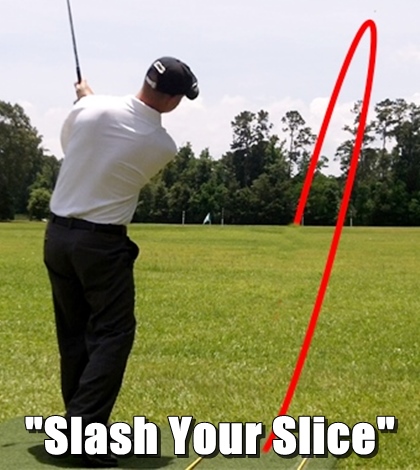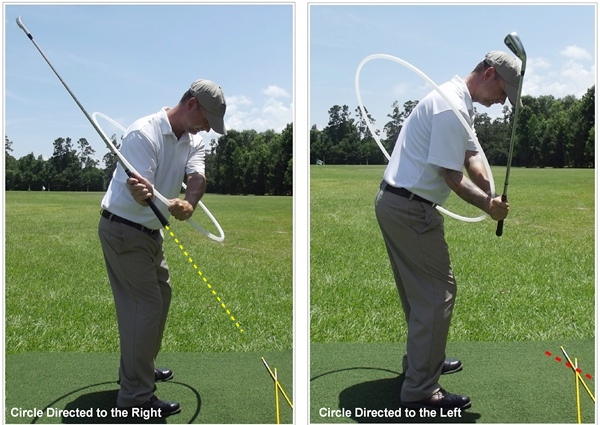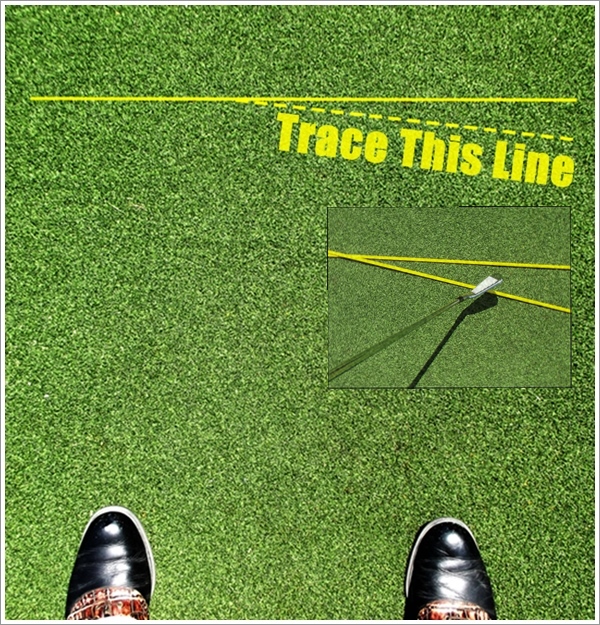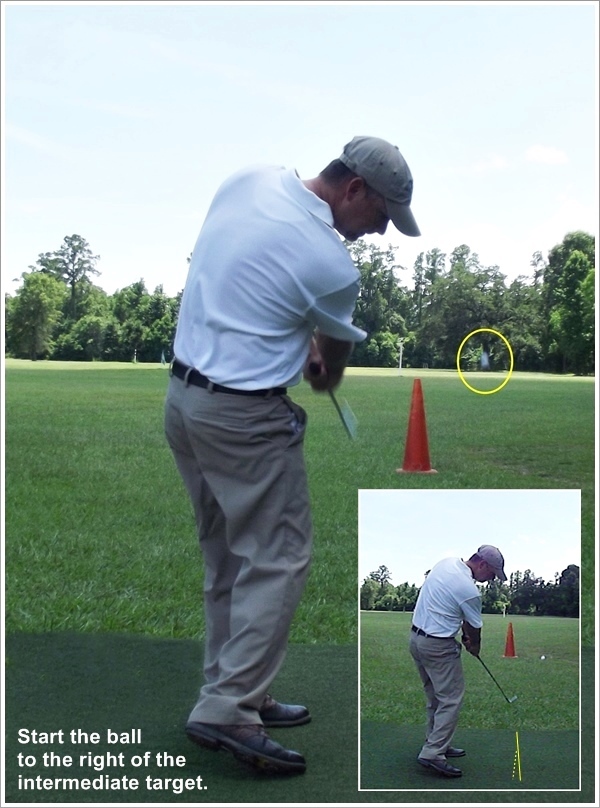Instruction
Slash Your Slice Part 2: Swing Path Control

Golfers only need to meet three conditions to hit the most sought after shot in golf, the draw, which for a right-handed golfer starts the ball a little to the right of the target and curves back.
- A clubface angle that is open to the target line.
- An inside-out swing path.
- A clubface angle slightly closed to the swing path.
We started addressing these conditions in the previous article, “Slash Your Slice Part 1,” and I discussed how to rotate the lead hand instead of flipping it. That helps golfers get a forward-leaning club shaft at impact, which gives them a clubface that is slightly open to the target line and satisfies condition No. 1. And a stronger grip allows the wrists and hands to respond properly to take care of condition No. 3.
Our goal now is to focus on condition No. 2, and develop an inside-out swing path. For the purposes of this article, I will refer to the golf swing as a circle. It is your job to give that circle proper direction. Here are several simple drills to help you do just that.
Directing the Circle
Swinging your circle to the right creates a powerful downswing sequence that starts from the ground up. The club shaft naturally flattens as the shoulders stay closed longer during the transition.
Directing your circle left from the top of the backswing throws the club shaft out and across our intended line. As stated in the Part 1, we must always be aware of “When and How Much” as we make changes to our golf swing. Slicers generally swing left too soon, spinning their trail shoulder “high and out” to start their downswing.
Trace the Line Drill
This drill works very quickly and does wonders for changing a slicer’s path. During lessons, I routinely see path numbers go from several degrees outside-in, to inside-out with this one simple change.
- Set up one line pointing at your target, and another line angled so that it is approaching from inside. Where the lines intersect is the imaginary ball.
- Begin making practice swings, tracing over the angled line with your club head during the downswing.
- Burn the image of these line relationships into your mind. Trace the angled line on every practice swing, then simply add a ball at their intersection.
Putting It All Together
- Place an intermediate object in-line with your primary target. Practice starting the ball to the right of the intermediate target and drawing it back.
- Trace your angled path line out to the right. This path, combined with your clubface angle, will create your new shot pattern.
The changes don’t have to be difficult. Work these simple drills and we will take a look at our pivot action in Part 3.
Check out the video below for more tips to slash your slice:
[youtube id=”0sAReBYA1AA” width=”620″ height=”360″]
- LIKE5
- LEGIT0
- WOW1
- LOL0
- IDHT0
- FLOP0
- OB0
- SHANK0
Instruction
Clement: Laid-off or perfect fade? Across-the-line or perfect draw?

Some call the image on the left laid off, but if you are hitting a fade, this could be a perfect backswing for it! Same for across the line for a draw! Stop racking your brain with perceived mistakes and simply match backswing to shot shape!
- LIKE0
- LEGIT0
- WOW0
- LOL0
- IDHT0
- FLOP0
- OB0
- SHANK1
Instruction
The Wedge Guy: The easiest-to-learn golf basic

My golf learning began with this simple fact – if you don’t have a fundamentally sound hold on the golf club, it is practically impossible for your body to execute a fundamentally sound golf swing. I’m still a big believer that the golf swing is much easier to execute if you begin with the proper hold on the club.
As you might imagine, I come into contact with hundreds of golfers of all skill levels. And it is very rare to see a good player with a bad hold on the golf club. There are some exceptions, for sure, but they are very few and very far between, and they typically have beat so many balls with their poor grip that they’ve found a way to work around it.
The reality of biophysics is that the body moves only in certain ways – and the particulars of the way you hold the golf club can totally prevent a sound swing motion that allows the club to release properly through the impact zone. The wonderful thing is that anyone can learn how to put a fundamentally sound hold on the golf club, and you can practice it anywhere your hands are not otherwise engaged, like watching TV or just sitting and relaxing.
Whether you prefer an overlap, interlock or full-finger (not baseball!) grip on the club, the same fundamentals apply. Here are the major grip faults I see most often, in the order of the frequency:
Mis-aligned hands
By this I mean that the palms of the two hands are not parallel to each other. Too many golfers have a weak left hand and strong right, or vice versa. The easiest way to learn how to hold the club with your palms aligned properly is to grip a plain wooden ruler or yardstick. It forces the hands to align properly and shows you how that feels. If you grip and re-grip a yardstick several times, then grip a club, you’ll see that the learning curve is almost immediate.
The position of the grip in the upper/left hand
I also observe many golfers who have the butt of the grip too far into the heel pad of the upper hand (the left hand for right-handed players). It’s amazing how much easier it is to release the club through the ball if even 1/4-1/2″ of the butt is beyond the left heel pad. Try this yourself to see what I mean. Swing the club freely with just your left hand and notice the difference in its release from when you hold it at the end of the grip, versus gripping down even a half inch.
To help you really understand how this works, go to the range and hit shots with your five-iron gripped down a full inch to make the club the same length as your seven-iron. You will probably see an amazing shot shape difference, and likely not see as much distance loss as you would expect.
Too much lower (right) hand on the club
It seems like almost all golfers of 8-10 handicap or higher have the club too far into the palm of the lower hand, because that feels “good” if you are trying to control the path of the clubhead to the ball. But the golf swing is not an effort to hit at the ball – it is a swing of the club. The proper hold on the club has the grip underneath the pad at the base of the fingers. This will likely feel “weak” to you — like you cannot control the club like that. EXACTLY. You should not be trying to control the club with your lower/master hand.
Gripping too tightly
Nearly all golfers hold the club too tightly, which tenses up the forearms and prevents a proper release of the club through impact. In order for the club to move back and through properly, you must feel that the club is controlled by the last three fingers of the upper hand, and the middle two fingers of the lower hand. If you engage your thumbs and forefingers in “holding” the club, the result will almost always be a grip that is too tight. Try this for yourself. Hold the club in your upper hand only, and squeeze firmly with just the last three fingers, with the forefinger and thumb off the club entirely. You have good control, but your forearms are not tense. Then begin to squeeze down with your thumb and forefinger and observe the tensing of the entire forearm. This is the way we are made, so the key to preventing tenseness in the arms is to hold the club very lightly with the “pinchers” — the thumbs and forefingers.
So, those are what I believe are the four fundamentals of a good grip. Anyone can learn them in their home or office very quickly. There is no easier way to improve your ball striking consistency and add distance than giving more attention to the way you hold the golf club.
More from the Wedge Guy
- The Wedge Guy: Golf mastery begins with your wedge game
- The Wedge Guy: Why golf is 20 times harder than brain surgery
- The Wedge Guy: Musings on the golf ball rollback
- LIKE88
- LEGIT14
- WOW6
- LOL1
- IDHT0
- FLOP4
- OB1
- SHANK8
Instruction
Clement: Stop ripping off your swing with this drill!

Not the dreaded headcover under the armpit drill! As if your body is defective and can’t function by itself! Have you seen how incredible the human machine is with all the incredible feats of agility all kinds of athletes are accomplishing? You think your body is so defective (the good Lord is laughing his head off at you) that it needs a headcover tucked under the armpit so you can swing like T-Rex?
- LIKE0
- LEGIT3
- WOW2
- LOL0
- IDHT0
- FLOP0
- OB0
- SHANK2
-

 19th Hole1 week ago
19th Hole1 week agoJustin Thomas on the equipment choice of Scottie Scheffler that he thinks is ‘weird’
-

 19th Hole1 week ago
19th Hole1 week ago‘Absolutely crazy’ – Major champ lays into Patrick Cantlay over his decision on final hole of RBC Heritage
-

 19th Hole3 weeks ago
19th Hole3 weeks agoTwo star names reportedly blanked Jon Rahm all week at the Masters
-

 19th Hole2 weeks ago
19th Hole2 weeks agoReport: LIV Golf identifies latest star name they hope to sign to breakaway tour
-

 19th Hole2 weeks ago
19th Hole2 weeks agoNeal Shipley presser ends in awkward fashion after reporter claims Tiger handed him note on 8th fairway
-

 19th Hole2 weeks ago
19th Hole2 weeks agoBrandel Chamblee has ‘no doubt’ who started the McIlroy/LIV rumor and why
-

 Equipment3 weeks ago
Equipment3 weeks agoWhat we know about Bryson DeChambeau’s 3D-printed Avoda irons
-

 19th Hole6 days ago
19th Hole6 days agoLET pro gives detailed financial breakdown of first week on tour…and the net result may shock you





















Bryan
Aug 7, 2013 at 4:56 pm
Mike, Thanks for the tips. I enjoy reading golfWRX and think this series if tutorials is really going to help with my miss (a high weak slice). I almost never draw the ball, a symptom of all my years of baseball I think. Can’t wait for part III!
Michael Howes
Aug 9, 2013 at 10:37 am
Good to hear from you Bryan. Part 3 is coming soon. In the meantime, keep working the drills from Parts 1 and 2 – your shot pattern WILL change. Thanks and see you soon in Part 3.